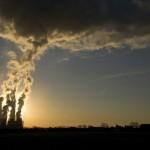 After a meeting last week in Luxembourg, the board of the European Investment Bank (EIB) changed its energy lending policy. The EU’s main lending arm said it would stop financing most coal-fired power stations to help reduce pollution and meet climate targets, and devote 90% of its lending to clean energy.
After a meeting last week in Luxembourg, the board of the European Investment Bank (EIB) changed its energy lending policy. The EU’s main lending arm said it would stop financing most coal-fired power stations to help reduce pollution and meet climate targets, and devote 90% of its lending to clean energy.
In a press release, the EIB says it ‘will focus on financing energy efficiency, renewable energy, energy networks, as well as related research and innovation. These sectors are expected to require the most significant investment in coming years’.
According to the Guardian the EIB has loaned around €11bn ($14.5bn) to fossil fuel-fired plants since 2007, most of it to gas rather than coal, out of its total lending for power of €83bn.
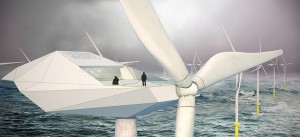 Growing interest in the rapidly-expanding offshore wind sector took a new twist earlier this week when the website of the influential US magazine Popular Science published an article featuring marine-based wind turbine concepts with “super-chic lofts for employees.”
Growing interest in the rapidly-expanding offshore wind sector took a new twist earlier this week when the website of the influential US magazine Popular Science published an article featuring marine-based wind turbine concepts with “super-chic lofts for employees.”
The article said that a Bulgarian design firm predicts a future in which gigantic offshore wind turbines come equipped with futuristic housing for workers.
“Part of the inspiration for these lofts was a European Wind Energy Association (EWEA) report estimating that by 2030, there will be over 300,000 jobs in offshore wind power,” the article said.
In fact, the European wind industry faces a severe skills shortage of around 7,000 appropriately qualified staff per year. This shortfall could climb to 15,000 by 2030 — nearly 2% of the entire wind industry workforce — if numbers of suitable workers don’t increase.
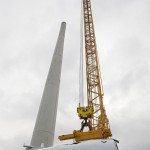 Greenhouse gases produced over the lifetime of a wind turbine – including for its manufacturing and installation – are less than that of fossil-fuel based energy sources and most other renewables, a new study from the US shows. Only ocean energy (wave and tidal) and hydropower have lower emissions than wind.
Greenhouse gases produced over the lifetime of a wind turbine – including for its manufacturing and installation – are less than that of fossil-fuel based energy sources and most other renewables, a new study from the US shows. Only ocean energy (wave and tidal) and hydropower have lower emissions than wind.
As a clean, fuel-free source of energy, wind turbines obviously create energy without generating the damaging pollutants that result from burning coal, gas and other fossil fuels. But a charge often leveled by anti-wind energy groups is that the manufacture and erection of wind turbines creates emissions on a scale that belies the idea that wind power is clean.
The Life Cycle Assessment (LCA) study by the National Renewable Energy Laboratory shows that wind energy‘s lifecycle greenhouse gas emissions are a small percentage of those of fossil fuels, lower than nuclear, and even lower than nearly all other renewable energy resources. From cradle to grave, coal-fired electricity releases about 20 times more greenhouse gases per kilowatt-hour than wind or solar, for example (based on median estimates for each technology). See the study for further details.
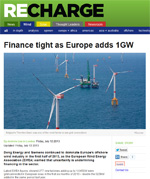 The release of EWEA’s offshore statistics for the first half of 2013 generated a lot of column inches around the world. The headlines were generally positive, reporting on the 277 offshore wind turbines newly grid connected in the first six months of this year. But the articles did not shy away from reporting on the warning signs evident in the sector, where financing of new projects has slowed down to a crawl.
The release of EWEA’s offshore statistics for the first half of 2013 generated a lot of column inches around the world. The headlines were generally positive, reporting on the 277 offshore wind turbines newly grid connected in the first six months of this year. But the articles did not shy away from reporting on the warning signs evident in the sector, where financing of new projects has slowed down to a crawl.
Many reports focused on the details of new offshore capacity, compared with the same period last year. The first half of 2012 saw around 500 MW installed, so this year’s 1,045MW was a doubling of that figure. The total offshore capacity installed last year, at 1.2GW, has almost been surpassed in the first six months of this year, bringing the overall offshore capacity in Europe to 6.04GW across 58 wind farms in ten countries.
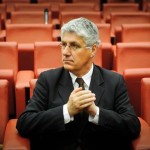 Philippe Martin is an important man. As France’s new environment minister, he occupies a key post in a government that will be pivotal in determining the EU’s post-2020 climate and energy policy.
Philippe Martin is an important man. As France’s new environment minister, he occupies a key post in a government that will be pivotal in determining the EU’s post-2020 climate and energy policy.
While no official position will be presented before the elections, there are little doubts that Germany will come out in favour a binding 2030 renewable energy target – which is critical for investor confidence in the wind energy sector – but the UK is officially against. France currently supports such a target but only at a later stage, after a greenhouse gas reduction target is in place.
The French government needs to realise the importance of setting three targets – for renewables, greenhouse gas reduction and energy efficiency – simultaneously, so that they can work together and mutually reinforce each other. Additionally, an ambitious three target package would highlight the EU’s leadership at the 2015 UN climate change meeting in Paris.
 After a meeting last week in Luxembourg, the board of the European Investment Bank (EIB) changed its energy lending policy. The EU’s main lending arm said it would stop financing most coal-fired power stations to help reduce pollution and meet climate targets, and devote 90% of its lending to clean energy.
After a meeting last week in Luxembourg, the board of the European Investment Bank (EIB) changed its energy lending policy. The EU’s main lending arm said it would stop financing most coal-fired power stations to help reduce pollution and meet climate targets, and devote 90% of its lending to clean energy.






 Comments
Comments



